41 labels on food explained
Food labels - NHS These labels provide information on the number of grams of fat, saturated fat, sugars and salt, and the amount of energy (in kJ and kcal) in a serving or portion of the food. But be aware that the manufacturer's idea of a portion may be different from yours. Some front-of-pack nutrition labels also provide information about reference intakes. What is a Karen? The 'white lady' viral nickname explained 2020-07-22 · COVID Karens are a special breed: The woman brawling with the Red Lobster staff, reduced because of the pandemic, because she had to wait too long for her food on Mother’s Day is a perfect example.
Fats | Nutrition.gov HHS, Food and Drug Administration, Center for Food Safety and Applied Nutrition Read about monounsaturated and polyunsaturated fats - what they are, where they are found, what they do, and how to use the Nutrition Facts Label to replace saturated fat …
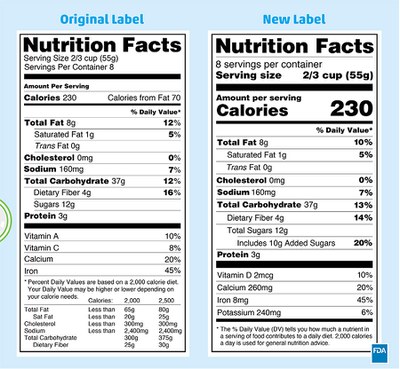
Labels on food explained
Food Labeling: MedlinePlus With this, you can figure out if a food is high or low in a nutrient: 5% or less is low, 20% or more is high. The information on a food label can help you see how a certain food or drink fits into your overall diet. The label lists, per serving,: The number of calories. Fats, including total fat, saturated fat, and trans fat. Cholesterol. Sodium. Food Label Terms and What They Really Mean - dummies The food must be low in fat or fat free. Plus, it must reflect the amount of fat present in a serving. In other words, if a food contains 5 grams of fat in a serving, it can be labeled "95 percent fat free.". Low-calorie. Fewer than 40 calories per serving. Many dieters find that portion control is real tricky. How To Read Food and Beverage Labels | National Institute on Aging At the top of the Nutrition Facts label, you will find the total number of servings in the container and the food or beverage's serving size. The serving size on the label is based on the amount of food that people may typically eat at one time and is not a recommendation of how much to eat. Read more about serving and portion sizes.
Labels on food explained. Understanding Dates on Food Labels - Eatright.org These are found primarily on perishable foods such as meat and dairy products. "Closed Dating" is a series of production numbers used by the manufacturer to indicate when a product was made. They primarily appear on shelf stable products such as cans and boxes of food. Except for infant formulas, product dates are not expiration dates. How to Read Nutrition Information → Food Labels EXPLAINED Learn how to read nutrition information on another level! Food labels EXPLAINED.Get our Fit Mother 30-Day Fat Loss Program here → ... Food Labels Explained: How to Read Food Labels - Fine Dining Lovers Logged Out Menu. Sign Up; Log In; Why Join Us? Connect. Primary Navigation. What's Hot. Turning The Tables; Coronavirus: Restaurant Resources Food Labels Explained | Goodheart Animal Sanctuaries Meat, dairy and egg labels can be misleading. Although around 80% of UK farm animals are reared in intensive systems, there's no law requiring food labels to say exactly how that animal has been raised (except for whole hen's eggs; powdered or liquid eggs require no such labelling). This means that although some people may find reassurance ...
Food Labels Explained - Farm Aid Food Labels Explained. Find Good Food. Whether it's at a farmers market, direct from farmers, or picking your own, there's a resource for you to to find good food from family farmers in your area. There are many different food labels that contain information about how food was grown or processed. However, some labels can be misleading. Food Labels And Nutrition Terms Explained - Beezzly Saturates. Understanding Food Labels. This sign means saturated fats. These are quite harmful since, when being intaken too much, they can cause heart problems and raise cholesterol. So try to purchase food without this marking or at least buy it more seldom. Understanding Food Nutrition Labels | American Heart Association Remember that the information shown in the label is based on a diet of 2,000 calories a day. You may need less or more than 2,000 calories depending upon your age, gender, activity level, and whether you're trying to lose, gain or maintain your weight. When the Nutrition Facts label says a food contains "0 g" of trans fat, but includes ... NCDA&CS - Kid's World - Understanding Food Labels Food labels show us if a food has a little or a lot of certain nutrients. Look on the side of a product to find the Nutrition Facts title. You will find the serving size of the food below the nutrition facts title. Similar food products have similar serving sizes. The servings per container are also included to let you compare what you actually ...
Understanding food labels | Diabetes UK The labels show how many calories are in the food or drink and are also colour coded to show whether the food is low (green), medium (amber) or high (red) in fat, saturated fat, sugar and salt. The information on the front of the pack also tells you how the portion of the food contributes to the Reference Intake (RI) of an adult. Food Labels Explained: What Do All Those Terms Really Mean? By definition from the USDA, an "all natural" food needs to be free of artificial ingredients or preservatives, and the ingredients are only minimally processed. However, this doesn't include antibiotics or hormones. While it still seems like it might be a better choice than food that doesn't say "all natural," unfortunately, the ... How to Read Food Labels Without Being Tricked - Healthline Study the Ingredients List ... Product ingredients are listed by quantity — from highest to lowest amount. This means that the first ingredient is what the ...Helps people make better food choices: can be ...Honest and transparent breakdown: most peop...Helpful for managing health conditions: not alw...Pros: ConsServing Sizes · Bottom Line · Pro: Transparent and... · Con: Not easy to interpret How to read food labels: MedlinePlus Medical Encyclopedia Always check the serving size first. All the information on the label is based on the serving size. Many packages contain more than 1 serving. For example, the serving size for spaghetti is most often 2 ounces (56 grams) uncooked, or 1 cup (0.24 liters) cooked. If you eat 2 cups (0.48 liters) at a meal, you are eating 2 servings.
Food labels - Better Health Channel Use-by and best-before dates on food labels. Foods with a shelf life of less than 2 years must have a best-before or use-by date. These terms mean different things. Best-before date on food labels. The best-before date refers to food quality - food stored in the recommended way will remain of good quality until that date.
Check the label | Food Standards Agency The traffic light label is colour coded and shows that green is low in a particular nutrient, amber means medium and red is high in a nutrient. means the product is high in a nutrient and you should try to cut down, eat less often or eat smaller amounts. means medium.
Healthy eating guide | Age UK What is a food label? All food manufacturers must use a standard label on the front of food packaging. Looking at the food labels found on most pre-packaged foods can help you make healthy choices. Try to get in the habit of reading pack labels and comparing brands before you buy. What information should be on a food label?
Food labelling | Food Standards Scotland Food labels are an excellent way of helping us make healthier choices, and many food and drink manufacturers and retailers use colour coded front of pack nutrition labels. These labels provide easy to understand information about calories and the levels of fat, saturated fat, sugars and salt in a product. Many of the foods with front of pack ...
How to understand food labels - Eat For Health Sometimes labels will include nutrition content claims like 'low fat', 'reduced salt' or 'high fibre'. These claims can only be used if the food meets certain criteria. For example, with a 'good source of calcium' claim, the food must contain more than a set amount of calcium. While nutrition content claims can generally guide ...
Guidance for cautionary and advisory labels | About | BNF … All of the existing labels were user-tested, and the revised wording selected reflects terminology that is better understood by patients. Wordings which can be given as separate warnings are labels 1–19, 29–30, and 32. Wordings which can be incorporated in an appropriate position in the directions for dosage or administration are labels 21 ...
Food labels explained | BHF Food labels explained Learn how to understand front-of-pack food labels, and how they can help you make heart-healthy choices more easily. When the Government recommended a front-of-pack food labelling system to all food retailers and manufacturers, we were thrilled that our campaigning efforts had paid off. The decision was announced in June ...
Understanding Food Labels - Nutrition: Science and Everyday Application The value printed on the Nutrition Facts panel is the percent DV, which tells you how much one serving of the food contributes towards meeting the daily requirement for that nutrient. The FDA uses the following definitions for interpreting the %DV on food labels:4. 5%DV or less means the food is low in a nutrient.
10 Rules For Reading a Food Label - YouTube The basics for understanding a nutrition label are important for every person to know. This video presents clear rules to properly read a food label. This vi...
Understanding Food Labels | The Nutrition Source | Harvard T.H. Chan ... Understanding Food Labels. The information on food labels is intended to help consumers become savvy about their food choices. The front, back, and sides of a package are filled with information to inform us what the food contains and to provide guidance in making healthier selections of processed foods. However, all the numbers, percentages ...
Figuring Out Food Labels (for Kids) - Nemours KidsHealth Percent daily value is most useful for seeing if a food is high or low in nutrients: A food with 5% or less of a nutrient is low in that nutrient. A food with 10%-19% of a nutrient is a good source of that nutrient. A food with 20% or more of a nutrient is high in that nutrient. The information on food labels is based on an average adult diet ...
9 Food Packaging Labels Explained - Dr. Sears Wellness Institute Labels can be misleading, especially if you don't learn to read between the lines and examine the fine print. Knowing what words on the label really mean is a big step toward making nutritious choices at the supermarket. Familiarize yourself with these 9 food labels so you can see the truth beyond the marketing. 1. "Pure"
How to Understand and Use the Nutrition Facts Label | FDA Overview. The information in the main or top section (see #1-4) of the sample nutrition label (below) can vary with each food and beverage product; it contains product-specific information ...
How To Decode & Understand Food Labels (in 5 Seconds) Food Labels & Nutrition Facts Explained. Three important metrics to compare packaged foods against. In a literal sense, a food label is meant to list all relevant and necessary background information describing food. The Nutrition Facts is a breakdown of the main nutrients inside. The FDA conveniently requires manufacturers to list the macro ...
What Do Food Labels Mean? - FoodPrint Some food labels are certifications. This means they meet certain standards and have been verified by a third-party certifier. Other labels are merely claims without any system of knowing if what they say is true or meaningful. A great example is the word "natural.". What does it mean?
Use-By, Sell-By, Best-By: Food Dating Labels Explained Labels Explained. "Best if Used By" or "Best if Used Before": The date the product will have its best flavor or quality. "Use-By": The last date the product will likely be at its ...
How To Read Food and Beverage Labels | National Institute on Aging At the top of the Nutrition Facts label, you will find the total number of servings in the container and the food or beverage's serving size. The serving size on the label is based on the amount of food that people may typically eat at one time and is not a recommendation of how much to eat. Read more about serving and portion sizes.
Food Label Terms and What They Really Mean - dummies The food must be low in fat or fat free. Plus, it must reflect the amount of fat present in a serving. In other words, if a food contains 5 grams of fat in a serving, it can be labeled "95 percent fat free.". Low-calorie. Fewer than 40 calories per serving. Many dieters find that portion control is real tricky.



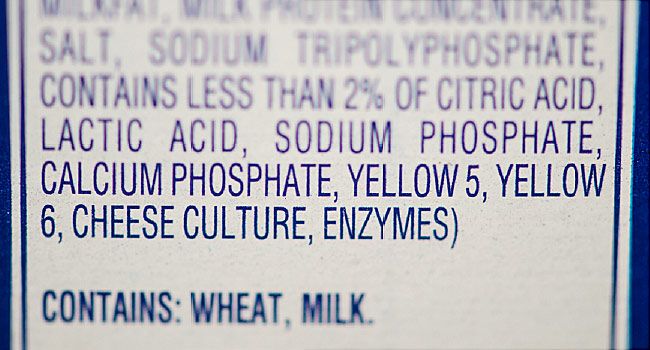


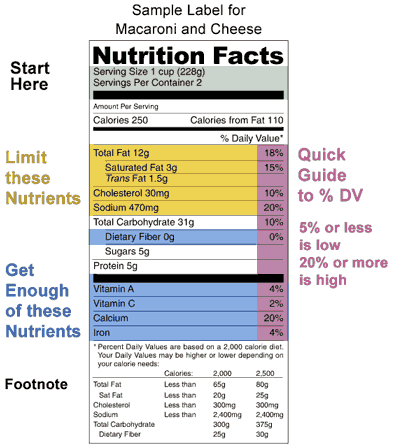
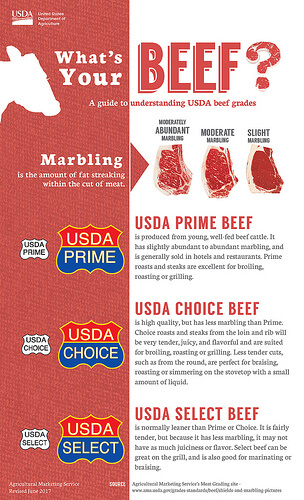


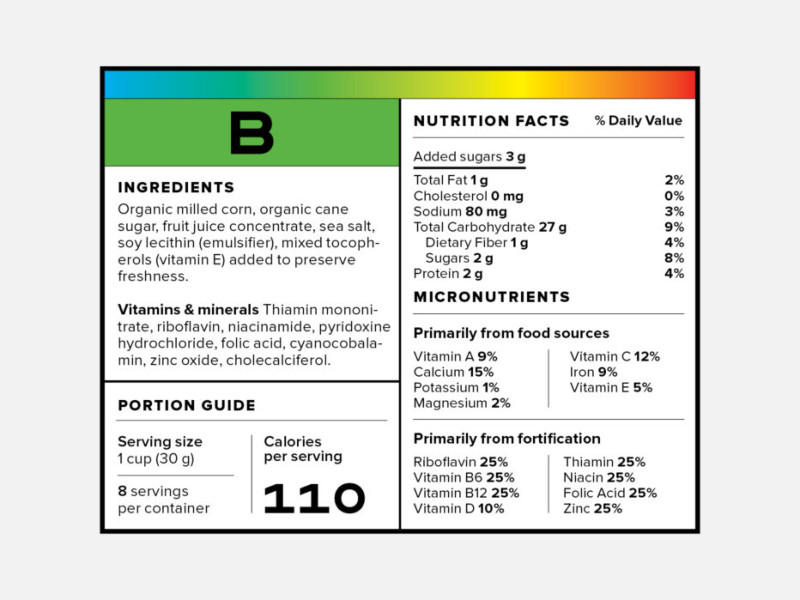
Post a Comment for "41 labels on food explained"